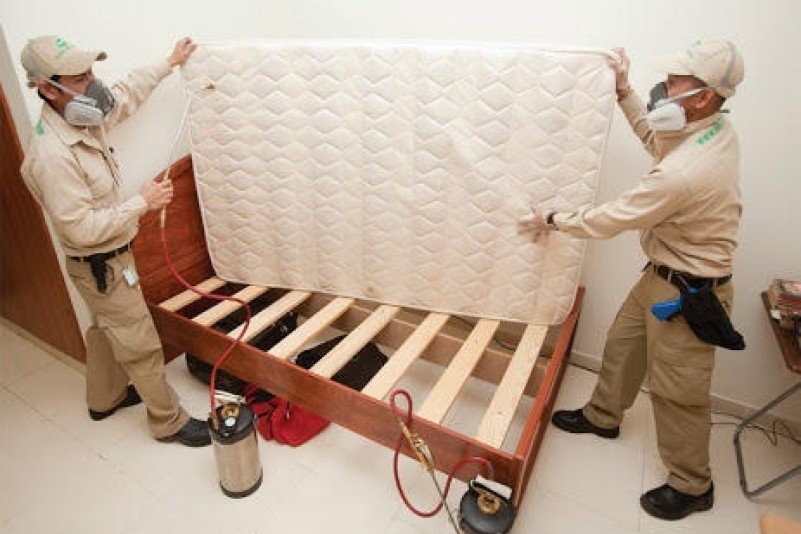Checking Out the Science Behind Bed Pest Heat Treatments as a Sustainable Parasite Management Technique
In the world of bug administration, the mission for lasting and efficient services stays a consistent quest. One such technique that has gained grip recently is the use of warm treatments to fight bed insect infestations. By utilizing the science behind thermal death points for these persistent parasites, warm therapies provide an appealing option to traditional chemical-based strategies. The ins and outs of exactly how heat properly eliminates bed bugs and the broader implications for sustainable parasite management methods make this a subject worth discovering further.
Bed Insect Warmth Therapy Refine

Thermal Fatality Factor for Bed Bugs
Revealing bed insects to elevated temperatures beyond their thermal tolerance array is crucial for accomplishing effective obliteration in heat therapy processes. The thermal fatality factor for bed pests refers to the temperature at which these pests can not survive. Research indicates that bed pests begin to perish when subjected to temperature levels above 113 ° F(45 ° C) for a sustained duration. As the temperature level boosts, so does the mortality rate of bed bugs. At around 118 ° F(48 ° C ), bed pests start to die swiftly, with a mortality price of virtually 99% within minutes of exposure. This demonstrates the sensitivity of bed insects to high temperatures and highlights the efficiency of heat treatments in eliminating infestations. By getting to and maintaining temperatures above the thermal fatality factor for bed pests, insect management specialists can ensure extensive removal of bed insect populations, consisting of hard-to-reach locations where chemical therapies might be much less reliable. Comprehending the thermal fatality point for bed pests is vital for implementing successful warm therapy strategies and attaining lasting pest administration outcomes.
Benefits of Warm Treatments
Having established the vital thermal death factor for bed pests, it is vital to now check out the significant benefits that warm therapies offer in efficiently eradicating these durable bugs. Heat treatments present several crucial benefits when contrasted to standard chemical methods. One of the key benefits is that warmth can pass through deep right into holes and cracks where bed insects hide, ensuring that even one of the most hard-to-reach locations are heated up to dangerous temperature levels. This comprehensive method not just eliminates live insects however also targets bed bug eggs, protecting against future invasions.
Furthermore, heat treatments are eco pleasant and safe, making them a sustainable parasite management approach. Unlike chemical pesticides, heat therapies do not leave hazardous deposits that can pose threats to human wellness or the check here environment. This element is specifically vital in sensitive environments such as health centers, institutions, and houses where chemical usage may not be preferable.
Furthermore, warmth treatments have a high success rate in removing bed insect infestations in a solitary treatment, lowering the demand for several check outs and decreasing interruption to occupants. This performance not just conserves money and time but additionally supplies assurance to those handling bed bug troubles.
Efficiency of Warmth Treatment

Research study studies have actually regularly demonstrated the efficiency of heat therapies in attaining a high price of bed pest mortality. Effectively carried out warmth therapies can reach all the splits and gaps where bed bugs may be nurturing, making certain a thorough method to elimination. Warm therapies have the included advantage of killing bed insect eggs, which are usually immune to traditional chemical treatments. Overall, the performance of warm treatments in eradicating bed pest invasions makes them a sustainable and trustworthy pest monitoring technique.
Lasting Insect Management Conveniences
Carrying out sustainable pest management techniques supplies long-term advantages for both the environment and public wellness. By utilizing techniques such as warmth therapies for insect control, we can decrease the reliance on harmful chemical pesticides that can have damaging effects on communities and human health and wellness - exterminator. Lasting bug monitoring methods assist in protecting biodiversity by targeting details insects without harming non-target organisms, thereby maintaining a balanced environment
Furthermore, sustainable insect monitoring methods add to the total here are the findings health and well-being of the public. By minimizing direct exposure to harmful chemicals utilized in typical bug control techniques, warmth treatments supply a safer option for parasite management in domestic, industrial, and public rooms. This reduction in chemical use likewise aids in preventing pesticide residues from contaminating water, dirt, and air, securing ecological quality.
Conclusion
To conclude, bed insect heat treatments have been revealed to be a lasting and efficient parasite monitoring method. The thermal fatality point for bed insects makes them at risk to warmth treatments, which have many advantages over conventional chemical therapies. The performance of warm treatments in removing bed pest problems while minimizing environmental impact highlights the potential of this technique as a lasting remedy for bug control.
The bed bug warm treatment procedure involves elevating the temperature within infested locations to a degree that efficiently gets rid of bed pests and their eggs. By getting to and preserving temperatures above the thermal fatality factor for bed bugs, pest monitoring specialists can guarantee thorough removal of bed bug populaces, including hard-to-reach areas where chemical treatments might be less efficient. One of the primary benefits is that heat can pass through deep right into gaps and splits where bed bugs hide, making certain that also the most hard-to-reach areas are heated to dangerous temperature levels. Unlike chemical therapies that might leave behind immune populations, warmth therapies use a environmentally pleasant and non-toxic service that can pass through deep right into furniture, wall surfaces, and various other hard-to-reach areas where bed pests hide.
The thermal fatality point for bed pests makes them susceptible to warmth therapies, which have many advantages over traditional chemical therapies.